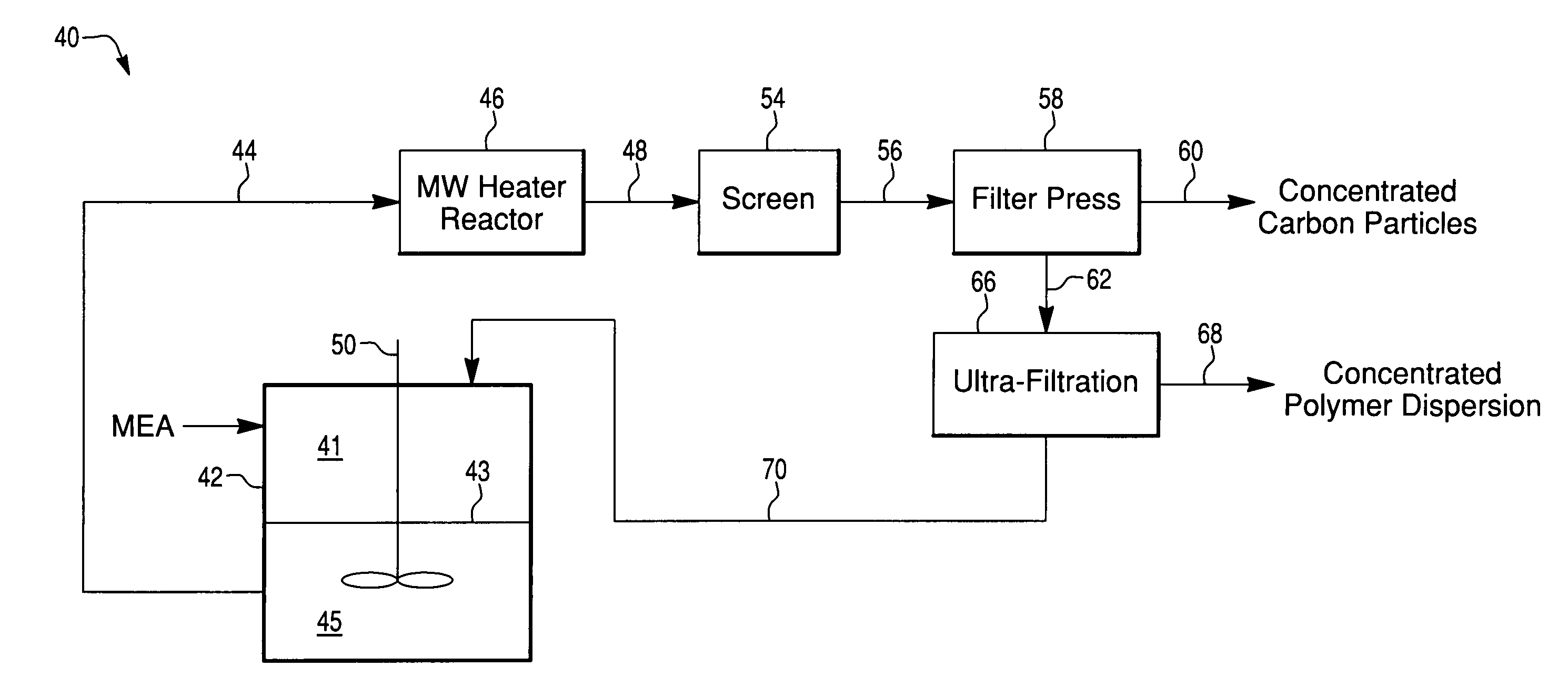Process for recycling components of a PEM fuel cell membrane electrode assembly
a technology of membrane electrode and fuel cell, which is applied in the direction of cell components, cell maintenance/service, separation process, etc., can solve the problems of high cost of proton exchange catalyst for fuel cell, the cost of efficient catalyst for low-temperature fuel cell is very high, and the total cost of such catalyst is approximately 80% of the total cost of manufacturing a low-temperature fuel cell
- Summary
- Abstract
- Description
- Claims
- Application Information
AI Technical Summary
Benefits of technology
Problems solved by technology
Method used
Image
Examples
example 1
[0043]Experiments were carried out on aged 5-layer MEAs with intact GDLs to compare loss of platinum (Pt) on the polymer membrane and / or on the GDL using different concentrations of isopropyl alcohol, 1-butanol and 2-butanol, See Table 1. The sample size used was 1 inch×1 inch in 20 ml of solvent, and the solvent volume was variable, estimated at 20 to 30 mL.
[0044]As can be seen from Table 1, loss of Pt on the polymer membrane and GDL were typically minimized with higher concentrations of alcohol.
[0045]
TABLE 1Comparison of Pt Recovery from Aged MEAs by Solvent Delamination% Pt left onSolventTemperature% Pt left on GDLmembrane50% isopropanol1000.90.525% isopropanol1001.01.010% isopropanol100274225% 2-butanol1001.02.410% 2-butanol1000.51.710% 2-butanol1502.11.7 5% 2-butanol1003625% 1-butanol10010% 1-butanol1000.60.4
example 2
[0046]Used MEAs were tested in a batch mode for total recovery of Pt using various alcohol concentrations and temperatures. Samples (as ½×½ or 1×1 inch squares) were placed into plastic bottles with solvent, as described. The samples were then heated to a desired temperature using a microwave heating device and incubated for 30 minutes without agitation.
[0047]
TABLE 2Comparison of recovery of Pt from aged MEAsSolventTemperature (° C.)Yield (%) 5% propanol15084.210% propanol1509825% propanol15096.6 5% propanol10011.810% propanol10030.425% propanol10098.1 5% n-butanol15094.510% n-butanol15093.325% n-butanol15094.9 5% n-butanol10095.910% n-butanol10098.925% n-butanol100100
example 3
[0048]Continuous
[0049]Used MEAs were tested in a batch mode for total recovery of Pt using various alcohol concentrations and temperatures. 1×1 inch samples were placed into plastic bottles with solvent, as described. After incubation the GDLs were separated from the carbon / polymer solution and sieved off. The solution was then pumped through a microwave heating device allowing for complete dispersion of the polymer. The solvent went from a translucent emulsion to a transparent dispersion. The carbon / noble metal (Pt) particles were separated from the dispersion using a filter press and the yield of recovered precious metal (Pt) quantified, see Table 3.
[0050]
TABLE 3Comparison of recovery of Pt from MEAsusing a continuous processPt Yield (%) (basedMEASolventTemperature (° C.)on residual Pt)New25% n-butanol10098.5Used25% n-butanol10099Used25% n-butanol15097Used25% n-butanol / 15098.85% 2-propanol
PUM
| Property | Measurement | Unit |
|---|---|---|
| radius | aaaaa | aaaaa |
| radius | aaaaa | aaaaa |
| temperature | aaaaa | aaaaa |
Abstract
Description
Claims
Application Information
 Login to View More
Login to View More - R&D
- Intellectual Property
- Life Sciences
- Materials
- Tech Scout
- Unparalleled Data Quality
- Higher Quality Content
- 60% Fewer Hallucinations
Browse by: Latest US Patents, China's latest patents, Technical Efficacy Thesaurus, Application Domain, Technology Topic, Popular Technical Reports.
© 2025 PatSnap. All rights reserved.Legal|Privacy policy|Modern Slavery Act Transparency Statement|Sitemap|About US| Contact US: help@patsnap.com


